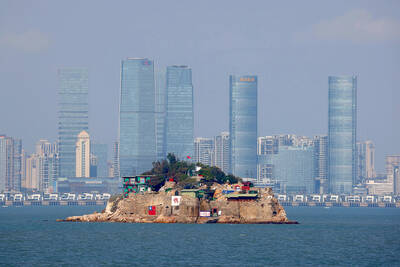As Taiwan struggles to enhance its submarine fleet, China is rapidly improving its anti-submarine warfare program, a study from Stratfor Global Intelligence said.
Stratfor is a US geopolitical intelligence firm that provides strategic analysis and forecasting to organizations around the world.
The days of Beijing relying on naval mines and depth charges for defense are coming to an end, the study said.
According to Stratfor, China has added Gaoxin-6 anti-submarine airplanes to its North Sea fleet, ramped up production of anti-submarine corvettes and equipped surface vessels with advanced detection equipment in the form of active variable-depth sonar and passive towed array sonar.
Stratfor said that China is also adding acoustic decoys and providing surface vessels with homing torpedoes.
The study came as high-level officials from Taiwan and the US meet in Washington this week for annual top-secret defense and security talks, during which Taiwan’s appeal for US help with its indigenous diesel-electric submarine program is believed to be on the agenda.
“The Chinese have been conducting extensive surveys and mapping of operating areas such as the South China Sea and are building a network of underwater sensors to detect submarines across the South and East China seas,” Stratfor said.
“On top of this, the [Chinese] military is experimenting with unmanned underwater vehicles with anti-submarine warfare applications. Most important, Chinese sailors, aircrew and technicians are consistently training to improve their skills,” it added.
Stratfor said that despite these advances, China’s anti-submarine defenses are still not sufficiently advanced or capable.
“While China could adequately clash with weaker powers such as Vietnam or Taiwan, the navy lacks the means to operate in the deep waters of the open ocean. It could not counter US nuclear submarines or even sophisticated diesel-electric submarines such as Japan’s.”
The study said that South Korea, Japan, Malaysia and Vietnam are developing or fielding large numbers of advanced diesel-electric submarines, a number of which are air-independent propulsion models, able to remain submerged for longer periods.
“Taiwan, a principal focus of Chinese war planning, is determined to build up its submarine fleet. With these improvements China now must contend with multiple submarine threats in most potential conflicts, making anti-submarine capabilities crucial,” the study said.
The study said that anti-submarine warfare is complex — equal parts art and science.
“It will take China years, if not decades, to become highly proficient in the craft. Moreover, the skillset is highly perishable. US Navy personnel even attest to how anti-submarine capabilities wane while the military focuses on other missions,” it said.

The Chinese Communist Party (CCP) is pushing for residents of Kinmen and Lienchiang counties to acquire Chinese ID cards in a bid to “blur national identities,” a source said. The efforts are part of China’s promotion of a “Kinmen-Xiamen twin-city living sphere, including a cross-strait integration pilot zone in China’s Fujian Province,” the source said. “The CCP is already treating residents of these outlying islands as Chinese citizens. It has also intensified its ‘united front’ efforts and infiltration of those islands,” the source said. “There is increasing evidence of espionage in Kinmen, particularly of Taiwanese military personnel being recruited by the

ENTERTAINERS IN CHINA: Taiwanese generally back the government being firm on infiltration and ‘united front’ work,’ the Asia-Pacific Elite Interchange Association said Most people support the government probing Taiwanese entertainers for allegedly “amplifying” the Chinese Communist Party’s propaganda, a survey conducted by the Asia-Pacific Elite Interchange Association showed on Friday. Public support stood at 56.4 percent for action by the Mainland Affairs Council and the Ministry of Culture to enhance scrutiny on Taiwanese performers and artists who have developed careers in China while allegedly adhering to the narrative of Beijing’s propaganda that denigrates or harms Taiwanese sovereignty, the poll showed. Thirty-three percent did not support the action, it showed. The poll showed that 51.5 percent of respondents supported the government’s investigation into Taiwanese who have

Left-Handed Girl (左撇子女孩), a film by Taiwanese director Tsou Shih-ching (鄒時擎) and cowritten by Oscar-winning director Sean Baker, won the Gan Foundation Award for Distribution at the Cannes Critics’ Week on Wednesday. The award, which includes a 20,000 euro (US$22,656) prize, is intended to support the French release of a first or second feature film by a new director. According to Critics’ Week, the prize would go to the film’s French distributor, Le Pacte. "A melodrama full of twists and turns, Left-Handed Girl retraces the daily life of a single mother and her two daughters in Taipei, combining the irresistible charm of

South Korean K-pop girl group Blackpink are to make Kaohsiung the first stop on their Asia tour when they perform at Kaohsiung National Stadium on Oct. 18 and 19, the event organizer said yesterday. The upcoming performances will also make Blackpink the first girl group ever to perform twice at the stadium. It will be the group’s third visit to Taiwan to stage a concert. The last time Blackpink held a concert in the city was in March 2023. Their first concert in Taiwan was on March 3, 2019, at NTSU Arena (Linkou Arena). The group’s 2022-2023 “Born Pink” tour set a